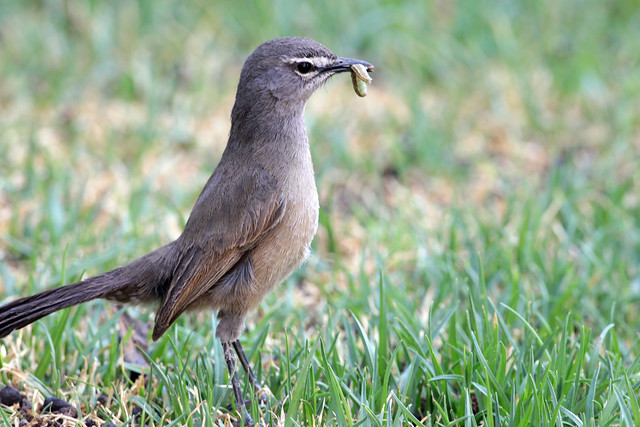Cercotrichas coryphaeus Cladus: Eukaryota Name Cercotrichas coryphaeus (Lesson, 1831) Vernacular names Reference Traite d'Ornithologie livr.6 p.419
The Karoo Scrub-robin or Karoo Robin (Erythropygia coryphaeus) is a species of bird in the Muscicapidae family. It is found in Lesotho, Namibia, and South Africa. Its natural habitats are dry shrubland and Mediterranean-type shrubby vegetation. Description It is 17 cm long and weighs 19 g. The upperparts are drab greyish brown; the face with a narrow, white supercilium above thin black eye-stripe. Partial whitish eye-ring below eye. Closed tail darker than rump and mantle. Upper wing coverts and flight feathers brown, underwing dull buffy brown. Bill black, eyes brown and legs as well as feet black. Song calls vary between individuals, e.g. chip, swee-chipswirraree, seeep-seeep-treeeeyer, repeated 5 – 10 times. Favours bare ground beneath ca. 1 m high vegetation and can be found in the low shrublands of the Karoo and Namaqualand in South Africa, in drainage line woodland. Also occasionally seen among tall vegetation at the base of farm dam walls. Nearly all food taken on ground, while its diet consists mainly of insects, dominated by worker ants that it gleans from the ground surface, and also including termites, beetles, caterpillars, moths and small grasshoppers. Monogamous, generally solitary nester with pairs remaining on defended territory from year to year. The nests are open, often deep cups sunk into variably sized platforms or large twigs and lined with fine, dry grass, leaf fragments and moss. Between 2 and 4 oval eggs of aquamarine or turquoise colour with brown spots and blotches. BirdLife International 2004. Erythropygia coryphaeus. 2006 IUCN Red List of Threatened Species. Downloaded on 25 July 2007. Source: Wikipedia,.Wikispecies: All text is available under the terms of the GNU Free Documentation License |
|

